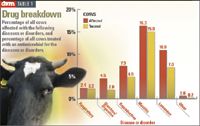USDA study eyes tred data on antimicrobial use
Fort Collins, Colo. — A United States Department of Agriculture (USDA) study reveals antimicrobials have been used more often to treat respiratory disease and mastitis than for all other diseases common among dairy operations.
FORT COLLINS, COLO. — A United States Department of Agriculture (USDA) study reveals antimicrobials have been used more often to treat respiratory disease and mastitis than for all other diseases common among dairy operations.
That trend represents data compiled from the National Animal Health Monitoring System (NAHMS) Dairy 2002 study. Recently released by USDA's Animal and Plant Health Inspection Service (APHIS), the report takes an in-depth look at use of antimicrobials on the nation's dairies.
While the information didn't proffer what author Dr. Jason Lombard considers surprises, the APHIS veterinary epidemiologist deems the numbers a "useful guide to what's going on in the industry." There aren't a lot of animals receiving antibiotics, he says. The Food and Drug Administration has safeguarded against the emergence of antimicrobial resistance in humans by imposing restrictions on antimicrobial drug use in food-producing animals.
"We couldn't quantify the volume of antimicrobials used; that would be tough," Lombard says. "Yet this shows a baseline to see how use changes as we move forward over time."
Reported facts
Titled "Part IV: Antimicrobial Use on U.S. Dairy Operations", the report breaks down age groups related to disease occurrences and their respective antibiotic treatments.
"We've never evaluated antimicrobial use to this extent before," Lombard says. "This gives the veterinary profession and our stakeholders a great foundation of information. Would a veterinarian pick some of this information out and consider it interesting, I think so."
According to the report, mastitis and lameness were the most common diseases or disorders affecting dairy cows, and of those affected with mastitis, more than 90 percent were treated with an antimicrobial compared to nearly 65 percent dealing with lameness.
The report also shows that mastitis led in the antibiotic treatment category with 15 percent of the more than 16 percent of all cases treated for the disease (see Table 1). Lameness ranked second with nearly 11 percent of all cows affected but just seven percent treated.

Drug breakdown
Antimicrobial class breakdown
Fifty-five percent of the cows treated with an antimicrobial for mastitis were on operations where beta-lactams were primarily used to treat the disease. More than 36 percent were on operations where cephalosporins were the primary antimicrobial used, and of the 7 percent of cows treated for lameness, beta-lactams, cephalosporins and tetracyclines were the most common antimicrobials used.
Of the 13.1 percent of unweaned heifers treated for diarrhea or other digestive ailments, sulfonamides were most employed with tetracyclines coming in a close second.
Regarding feed, approximately one in four weaned dairy heifers received anti-microbials in heifer rations although a higher percentage of those animals resided on medium or large operations. In addition, a higher percentage of large operations compared to those of other sizes do not feed medicated milk replacer to unweaned heifers. When unweaned dairy heifers were fed medicated milk replacer, oxytetracycline with neomycin was the most common medication used in the product.